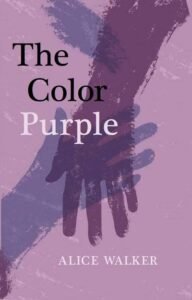
The Color Purple was first published in 1982 and won critical acclaim with the Pulitzer Prize for Fiction and the National Book Award for Fiction. It was later adapted into a film with the same name in 1985 and 2023 and has been regularly debated due to the themes of violence and domestic abuse, and censorship in the USA. But, to me, The Color Purple is such a powerful read, touching on so many important topics that define human nature. A story filled with injustice, time and time again: injustice of being a black women in America, injustice of the slave trade, injustice of colonialism; Alice Walker so importantly captures all these heavily linked experiences.
The book is based in the early 1900s in rural Georgia, and starts as one of childhood trauma told through Celie, who writes letters to God about her abusive home life. During her childhood, she always found peace in God and used the watchful eye of God as a reason to push through the hard times with grace. I was amazed how gracious she was, given the life she was forced to live, showing her true character and incredible resilience. Celie is close to her sister, but is forced to marry, whilst her sister escapes the abusive home and consignment to marriage by becoming a missionary. Unfortunately for Celie, there was no escape and the abuse continues in her marriage.
The book covers an array of complex relationships for Celie, covering old and new love, loss, and hope. She finds solace in friendship, but her relationship with God flounders under strain. Once her love of God is lost, the book turns into one of reflection. At one point, Celie is asked, what her god looks like? And I find that an interesting one. In this sense it’s referring to the Christian God but even those without a god have somewhere to look for hope and guidance. Everyone has a version of a god, they just don’t always look the same, which is reflected by Celie’s changing relationship with God throughout.
As well as her struggle with religion, Celie’s identity is reflected upon, the book covering the complexities of being a wife, a stepmother and handling her husband’s mistress. Reflection of identity is also seen with her sister’s story, which is told through letters Celie receives whilst her sister travels to England and West Africa during her missionary work. Her letters detail the challenges she experiences in England as a Black woman, and in Africa as a Black American, where she isn’t truly accepted into the village.
There is a theme of love throughout the book, love between the two sisters, lasting decades apart, love for her lost children, love for her friends, her lover. It shows the true power of love to be resilient. You find you have developed with the book, have changed your viewpoint of it as you read and have grown with it in understanding how trauma of all kinds forces us to adapt. What began as a book of trauma, turns into skillfully constructed self reflection and growth for Celie.
If you’ve also somehow missed this book like me, I’d highly recommend it!
C